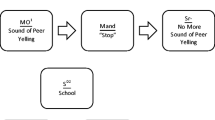Abstract
Skinner’s (1957) analysis of verbal behavior suggests the functional independence of the verbal operants. However, only a few empirical studies have directly examined the nature of these operants, and their independence. The present study evaluated whether teaching topographies as tacts would lead to their emission as mands. The results indicated that manding only occurred reliably after direct mand training, which consisted of the use of imitative and tact prompts, and fading those prompts, to transfer stimulus control from nonverbal stimuli to conditioned establishing operations. The results contribute to the existing data on the functional independence of mands and tacts, as well as demonstrate the value of manipulating conditioned establishing operations for mand training.
Similar content being viewed by others
References
Baer, D., Wolf, M., & Risley, T. (1968). Some current dimensions of applied behavior analysis. Journal of Applied Behavior Analysis, 1, 91–97.
Carr, E. G., & Durand, V. M. (1985). Reducing behavior problems through functional communication training. Journal of Applied Behavior Analysis, 18, 111–126.
Carr, E. G., & Kologinsky, E. (1983). Acquisition of sign language by autistic children. II: Spontaneity and generalization effects. Journal of Applied Behavior Analysis, 16, 297–314.
Charlop, M. H., Schreibman, L., & Thibodeau, M. G. (1985). Increasing spontaneous verbal responding in autistic children using a time delay procedure. Journal of Applied Behavior Analysis, 18, 155–166.
Halle, J. W., Baer, D. M., & Spradlin, J. E. (1981). Teacher’s generalized use of delay as a stimulus control procedure to increase language use in handicapped children. Journal of Applied Behavior Analysis, 14, 389–409.
Halle, J. W., Marshall, A. M., and Spradlin, J. E. (1979). Time delay: A technique to increase language use and facilitate generalization in retarded children. Journal of Applied Behavior Analysis, 12, 431–439.
Hart, B., & Risley, T. R. (1968). Establishing use of descriptive adjectives in the spontaneous speech of disadvantaged preschool children. Journal of Applied Behavior Analysis, 1, 109–120.
Hart, B., & Risley, T. R. (1974). Using preschool materials to modify the language of disadvantaged children. Journal of Applied Behavior Analysis, 7, 243–256.
Hart, B., & Risley, T. R. (1975). Incidental teaching of language in the preschool. Journal of Applied Behavior Analysis, 8, 411–420.
Hart, B., & Risley, T. R. (1980). In vivo language intervention: Unanticipated general effects. Journal of Applied Behavior Analysis, 13, 407–432.
Lamarre, J., & Holland, J. (1985). The functional independence of mands and tacts. Journal of the Experimental Analysis of Behavior, 43, 5–19.
Lee, V. L. (1981). Prepositional phrases spoken and heard. Journal of the Experimental Analysis of Behavior, 35, 227–242.
Lee, V. L., & Pegler, A. (1982). Effects on spelling of training children to read. Journal of the Experimental Analysis of Behavior, 37, 311–322.
Lovaas, O. I. (1977). The autistic child: Language development through behavior modification. New York: Irvington Publishers, Inc.
Michael, J. L. (1982a). Distinguishing between the discriminative and motivational functions of stimuli. Journal of the Experimental Analysis of Behavior, 37, 149–155.
Michael, J. L. (1982b). Skinner’s verbal operants: Some new categories. The Analysis of Verbal Behavior, 1,1.
Michael, J. L. (1987). Advanced topics in behavior analysis. Unpublished paper.
Michael, J. L., Whitley, P., & Hesse, B. E. (1983). The pigeon parlance project. The Analysis of Verbal Behavior, 2, 6–9.
Peterson, N. (1978). An introduction to verbal behavior. Grand Rapids, MI: Behavior Associates, Inc.
Savage-Rumbaugh, S.E. (1984). Verbal behavior at a procedural level in the chimpanzee. Journal of the Experimental Analysis of Behavior. 41, 223–250.
Sidman, M. (1971). Reading and auditory-visual equivalences. Journal of Speech and Hearing Research, 14, 5–17.
Simic, J., & Bucher, B. (1980). Development of spontaneous manding in nonverbal children. Journal of Applied Behavior Analysis, 13, 523–528.
Skinner, B. F. (1957). Verbal behavior. Appleton-Century-Crofts, New York.
Sundberg, M. L. (1985). Teaching verbal behavior to pigeons. The Analysis of Verbal Behavior, 3, 11–17.
Ulman, J. D., & Sulzer-Azaroff, B. (1975). Multielement baseline design in educational research. In E. Ramp & G. Semb (Eds.), Behavior analysis: Areas of research and application. Englewood Cliffs, NJ: Prentice-Hall.
Vargas, E. (1986). Intraverbal behavior. In L. J. Parrott & P. N. Chase (Eds.), Psychological aspects of language: The West Virginia lectures (pp. 128–151). Springfield: C. C. Thomas.
Author information
Authors and Affiliations
Additional information
Portions of this paper are based on a thesis submitted by the senior author to Western Michigan University in 1979, in partial fulfillment of the requirement of a masters degree.
The authors wish to thank Gerald L. Shook, former coordinator of the Kalamazoo Valley Multihandicap Center (now Croyden Ave School), for his administrative support for this research. Appreciation is also extended to Mark Stafford and Ray Miltenberger for their assistance in conducting the study, and to Jack Michael, Wayne Fuqua and David Ray for their helpful comments on an earlier version of the manuscript.
Rights and permissions
About this article
Cite this article
Hall, G., Sundberg, M.L. Teaching mands by manipulating conditioned establishing operations. Analysis Verbal Behav 5, 41–53 (1987). https://doi.org/10.1007/BF03392819
Published:
Issue Date:
DOI: https://doi.org/10.1007/BF03392819




